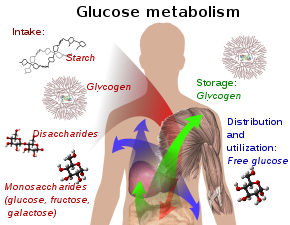| Glucose tolerance test | |
|---|---|
 A diagram of glucose metabolism | |
| Purpose | determine how quickly glucose is cleared from blood |
The glucose tolerance test (GTT, not to be confused with GGT test) is a medical test in which glucose is given and blood samples taken afterward to determine how quickly it is cleared from the blood.[1] The test is usually used to test for diabetes, insulin resistance, impaired beta cell function,[2] and sometimes reactive hypoglycemia and acromegaly, or rarer disorders of carbohydrate metabolism. In the most commonly performed version of the test, an oral glucose tolerance test (OGTT), a standard dose of glucose is ingested by mouth and blood levels are checked two hours later.[3] Many variations of the GTT have been devised over the years for various purposes, with different standard doses of glucose, different routes of administration, different intervals and durations of sampling, and various substances measured in addition to blood glucose.
- ^ Glucose+Tolerance+Test at the U.S. National Library of Medicine Medical Subject Headings (MeSH)
- ^ DeFronzo RA, Abdul-Ghani M (2011). "Assessment and treatment of cardiovascular risk in prediabetes: impaired glucose tolerance and impaired fasting glucose". American Journal of Cardiology. 108 (3 Suppl): 3B–24B. doi:10.1016/j.amjcard.2011.03.013. PMID 21802577.
- ^ Institute for Quality and Efficiency in Health Care. "Glucose tolerance test: how does it work exactly?". Informed Health Online. Institute for Quality and Efficiency in Health Care. Retrieved 22 June 2013.